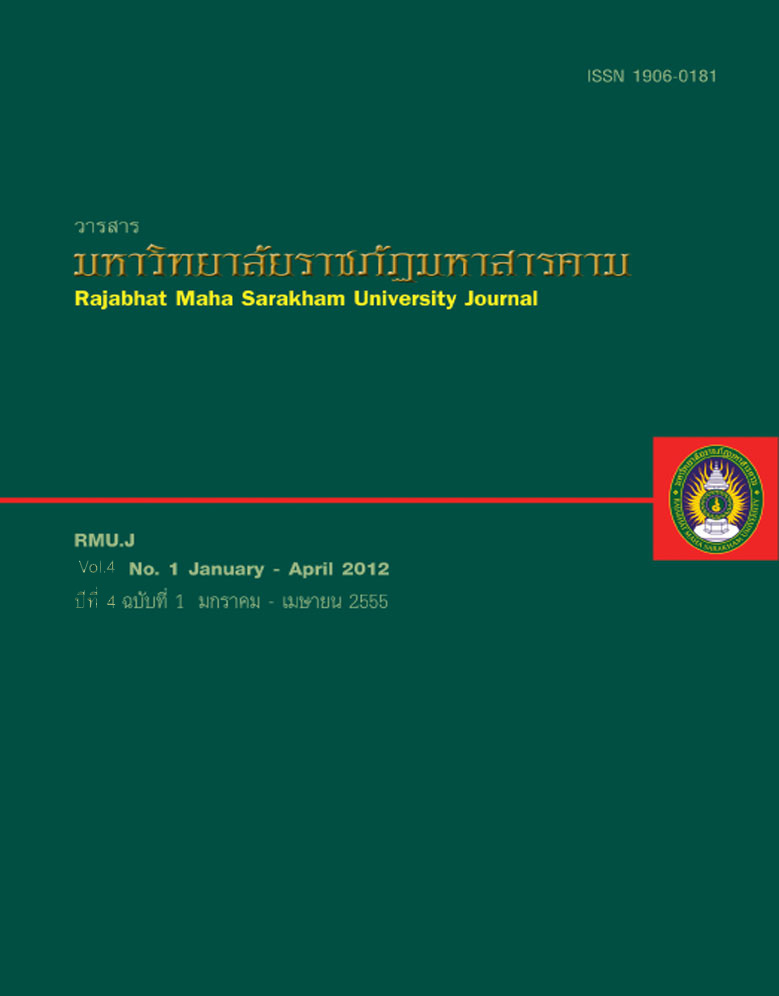การพัฒนารูปแบบกิจกรรมการเรียนรู้วิชาระบบปฏิบัติการ 1 หลักสูตรวิทยาศาสตรบัณฑิต สาขาวิชาวิทยาการคอมพิวเตอร์ มหาวิทยาลัยราชภัฏกาฬสินธุ์
Main Article Content
บทคัดย่อ
การวิจัยนี้มีวัตถุประสงค์ดังนี้ ประการแรกเพื่อพัฒนารูปแบบกิจกรรมการเรียนรู้วิชาระบบปฏิบัติการ 1 สาขาวิชาวิทยาการคอมพิวเตอร์ หลักสูตรวิทยาศาสตรบัณฑิต มหาวิทยาลัยราชภัฏกาฬสินธุ์ ประการที่สองเพื่อหาประสิทธิภาพของกิจกรรมการเรียนรู้วิชาระบบปฏิบัติการ 1 ที่พัฒนาขึ้น ประการที่สามเพื่อเปรียบเทียบผลสัมฤทธิ์ทางการเรียนของกลุ่มผู้เรียนที่จัดการเรียนการสอนด้วยกิจกรรมการเรียนรู้ ที่พัฒนาขึ้น ประการที่สี่เพื่อหาความพึงพอใจของผู้เรียนที่มีต่อกิจกรรมการเรียนรู้วิชาระบบปฏิบัติการ 1 และประการที่ห้าเพื่อหาความคงทนทางการเรียนของผู้เรียน วิธีดำเนินการวิจัยมีขั้นตอน ประกอบด้วย
การวิเคราะห์สภาพปัญหาทั่วไป การออกแบบรูปแบบกิจกรรมการเรียนรู้ การพัฒนารูปแบบกิจกรรมการเรียนรู้ การทดลองใช้รูปแบบกิจกรรมการเรียนรู้ และการทำเอกสาร เครื่องมือที่ใช้ในการวิจัยได้แก่ รูปแบบกิจกรรมการเรียนรู้วิชาระบบปฏิบัติการ 1
แบบสอบถามความพึงพอใจ และแบบทดสอบวัดผลสัมฤทธิ์ทางการเรียน กลุ่มตัวอย่างที่ใช้ในการทดลองงานวิจัยจำนวน 15 คน
ผลการวิจัยพบว่าได้รูปแบบกิจกรรมการเรียนรู้วิชาระบบปฏิบัติการ 1 ชื่อว่า LA-OS model ประกอบด้วยกิจกรรมการเรียนรู้ 8 ขั้นตอนได้แก่ บอกจุดประสงค์การเรียนรู้ของบทเรียน ประเมินผลก่อนเรียน ทบทวนความรู้เบื้องต้น บรรยายแบบปฏิสัมพันธ์ ศึกษา
เรียนรู้ด้วยตนเอง อภิปรายและสรุปผลการเรียนรู้ ประเมินผลหลังเรียน และสรุปผลกิจกรรมการเรียนรู้ เครื่องมือของกิจกรรมการเรียนรู้ประกอบด้วย เอกสารประกอบการสอน งานนำเสนอ บทเรียนคอมพิวเตอร์ช่วยสอน ใบงานประกอบการบรรยาย
ผลการวิเคราะห์ความเห็นต่อรูปแบบกิจกรรมการเรียนรู้วิชาระบบปฏิบัติการ 1 ผู้เชี่ยวชาญมีความคิดเห็นต่อรูปแบบกิจกรรมการเรียนรู้วิชาระบบปฏิบัติการ 1 ผู้เชี่ยวชาญมีความเห็นต่อรูปแบบในภาพรวม มีค่าเฉลี่ยอยู่ในระดับมากประสิทธิภาพของกิจกรรม
การเรียนรู้วิชาระบบปฏิบัติการ 1 มีประสิทธิภาพสูงกว่าเกณฑ์ที่กำหนด (80.13/80.90) ผู้เรียนที่ได้รับการจัดกิจกรรมการเรียนรู้ที่ พัฒนาขึ้นมีผลสัมฤทธิ์ทางการเรียนที่ระดับนัยสำคัญทางสถิติ .05 และความพึงพอใจของผู้เรียนอยู่ในระดับมาก ดังนั้นรูปแบบ
ที่ผู้วิจัยพัฒนาขึ้นจึงเป็นรูปแบบที่มีประสิทธิภาพ สามารถนำไปใช้ในการจัดการเรียนการสอนได้
The purposes of this research were to 1) develop the learning activity model for Operating
System Course I, Bachelor of Science Degree Program, Computer Science, Rajabhat Kalasin
University, 2) assess the efficiency of the developed model, 3) to compare achievement of students who
studied “Operation System Course I” using the learning activity model, 4) survey students’ satisfaction
with the learning activity model for Operation System Course I, and 5) study students’ learning retention
after using the learning activity model.
This research consisted of 5 phases: problem analysis, 2) design of learning activities, 3)
development of learning activity model, 4) try-out of the model, and 5) documentation. The research
instruments were learning activities for Operation System Course I, a questionnaire, and an
achievement test. Subjects of the study were 15 computer major students of the Computer Science
Program, Rajabhat Kalasin University. The statistics used in this research were percentage, mean,
standard deviation and t-test.
Results of the study were as follows:
A learning activity model for Operation System Course I called “the LA-OS Model” was
developed for the Bachelor of Science Degree Program in Computer Science, Rajabhat Kalasin
University. The LA-OS Model consisted of the following 8 steps of learning activities: 1) identifying
learning objectives of the lesson, 2) pre-test, 3) background knowledge review, 4) an interactive lecture,
5) self-study, 6) discussion and conclusion of learning outcomes, 7) post-test, 8) conclusion of results of
learning activities. The instruments for this learning activity model included workbook, presentation
material, computer-assisted instruction lesson/unit/program, and lecture worksheets. Analysis of
opinions towards the learning activity model for “Operation System Course I” using the ADDID Model
revealed that the experts’ overall opinion on this learning activity model was high (X
–
=4.21, S.D. =0.70).
The efficiency value of the model (80.13/80.90) was higher than the assigned criteria (80/80). The posttest
achievement of the students was significantly higher than that of the pretest at the .05 level. With
regard to subjects’ satisfaction, the study revealed that their satisfaction with the learning model was
high (X–=4.04, S.D. =0.07). In conclusion, findings of the study indicate that the learning activities using
the ADDID Model is an efficient one and should be used with other computer classes.
Article Details
1. บทความที่ลงตีพิมพ์ทุกเรื่องได้รับการตรวจทางวิชาการโดยผู้ประเมินอิสระ ผู้ทรงคุณวุฒิ (Peer Review) สาขาที่เกี่ยวข้อง อย่างน้อย 3 ท่าน ในรูปแบบ Double blind review
2. ข้อคิดเห็นใด ๆ ของบทความที่ลงตีพิมพ์ในวารสารมหาวิทยาลัยราชภัฏมหาสารคาม นี้เป็นของผู้เขียน คณะผู้จัดทำวารสารไม่จำเป็นต้องเห็นด้วย
3. กองบรรณาธิการวารสารมหาวิทยาลัยราชภัฏมหาสารคาม ไม่สงวนสิทธิ์การคัดลอกแต่ให้อ้างอิงแสดงที่มา


